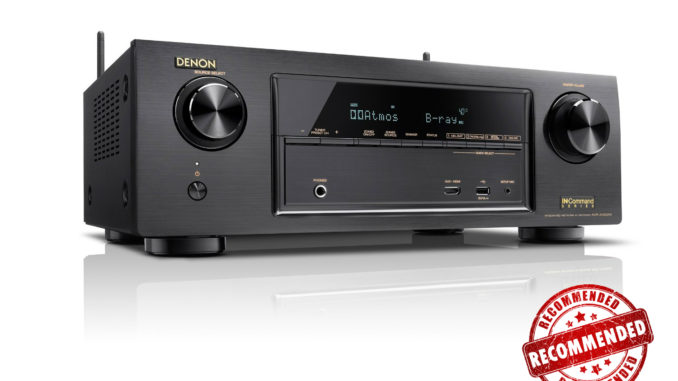
Denon’s new line of AV receivers consists of nine models, beginning with the entry-level AVR-S510BT and ends with the top-of-the-line AVR-X7200WA. The cheapest model only covers the basics with 5.2 channels and no network capabilities, while the flagship model goes all out with everything you’ll ever need and more.
Denon AVR-X1200W
-
Sound Quality - 80%80%
-
Features - 90%90%
-
Ease of Use - 90%90%
-
Build Quality - 90%90%
SUMMARY
With a balanced, neutral and dynamic sound combined with easy installation, setup and use, this Denon is the perfect choice for any home theater enthusiast.
Dynamic sound
Bluetooth and Wi-Fi
Dolby Atmos & DTS:X
HD audio streaming
Lacks that last ounce of detail and resolution
Somewhere in between these you find the AVR-X1200W, which cost just over twice as much as the 510 but five times less than the 7200, offering 7.2 channels, HD Audio streaming via Bluetooth and Wi-Fi, and Immersive Sound (Dolby Atmos and DTS:X (future firmware update)), making it an interesting option for the more budget-conscious customer. Now, let's see what it can do...
Design & Features
Measuring in at 17.1 x 5.9 x 13.3 inches (434 x 149 x 338 mm) and weighing a relatively low 18.7 pounds (8.5 kg) meant that unpacking and setting it up was fairly uncomplicated. As the AVR-X1200W support Immersive Sound formats like Dolby Atmos, we opted for a 5.1.2 configuration using two Klipsch RP-140SA height speakers in conjunction with a Reference Premiere surround system, but it is of course possible to use the seven amplifiers in a more traditional 7.2 configuration. If you’re inexperienced in setting up home theater systems, you’ll be pleased to know that the X1200W has a very helpful ‘Setup Assistant’ that takes you through the necessary steps to set up your home theater system in the easiest and quickest way possible.
When it comes to acoustic calibration, Denon has once again opted for Audyssey, in this case the Silver edition (including MultEQ XT, Dynamic EQ and Dynamic Volume). While other manufacturers have developed their own proprietary calibration systems (with varying results), Audyssey is still considered to be one of the best, and with the results we got with Onkyo's AccuEQ (TX-NR545 and RZ800) in mind, we are inclined to agree.
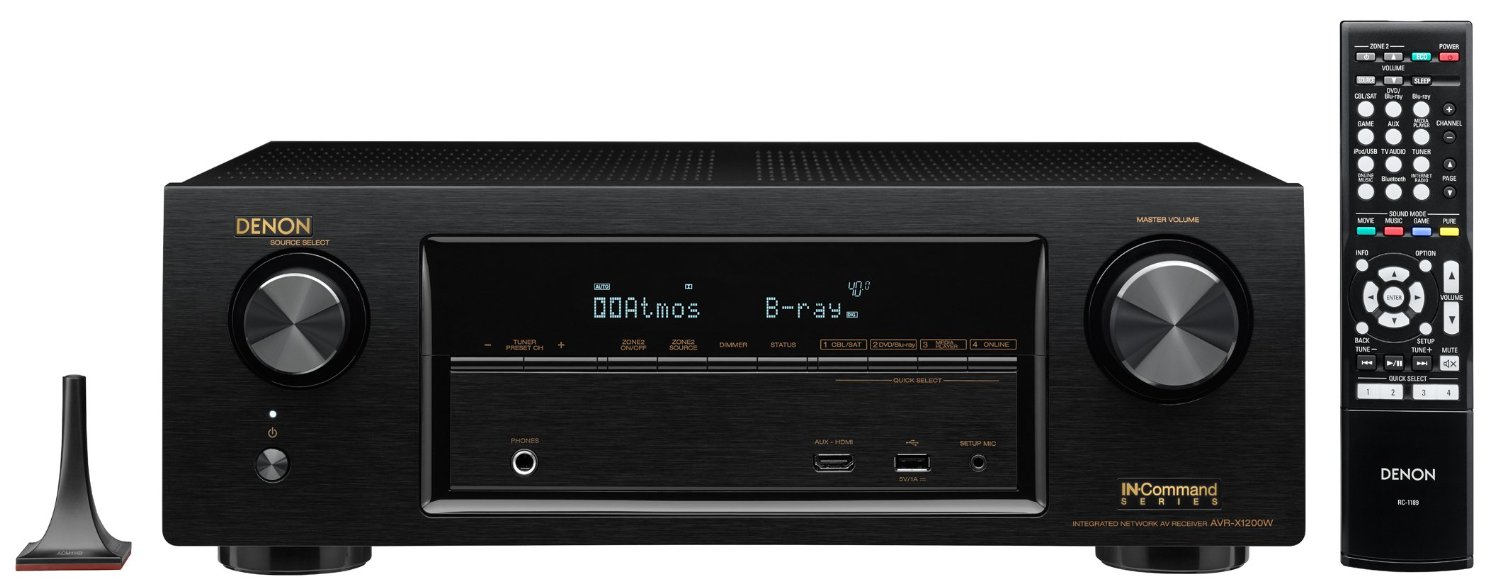
Being a few steps up on the Denon receiver-ladder the AVR-X1200W offers two extra power amplifiers, rated at 120 W (6 ohm, 1 kHz, 0.7% 2ch Drive), and full network capability, compared to the entry-level AVR-S510BT that has none of the above. You can connect to your network by either using a cable and connect it to the ethernet port on the back, or wirelessly using the built-in RF transceiver and its dual antennas.
Using the Wi-Fi and Bluetooth capabilities you can enjoy services like Spotify Connect, internet radio stations, AirPlay and stream DSD, FLAC, ALAC and AIFF High Resolution audio from local network storage drives. We had no problems connecting to our network or Bluetooth devices and perfomance remained stable throughout the whole test.
Connectivity
We really shouldn´t be surprised by now, but it is quite remarkable how much versatility Denon has managed to cram in when it comes to connectivity, despite only being one of their cheaper models. The AVR-X1200W offers:
INPUTS
- 6 x HDMI (Front 1) 4K/60 Hz full-rate pass-through and 4:4:4 color resolution, HDCP 2.2
- 2 x Composite (video)
- 2 x Analog Audio
- 2 x Digital Optical
- 1 x Digital Coaxial
- 1 x USB (front)
- 1 x FM Antenna
- 1 x AM Antenna
- 1 x Ethernet Port
- 1 x Calibration Microphone
OUTPUTS
- 1 x HDMI Monitor (ARC)
- 1 x Composite Monitor
- 0.2 ch Audio Preout (SW)
- 1 x Phones
...and, of course, seven pairs of speaker terminals (Front L+R, Center, Surround L+R, Surround Back L+R).
Remote Control & App
The remote control (RC-1189) is more or less the same as the one you got with the previous model, the AVR-X1100W, but that’s ok as it works pretty well and has a nice layout of the buttons. However, if you own a smartphone or tablet you can download Denon’s Remote App for iOS and Android, which allows you to perform some basic controls for Denon’s AV receivers, like turning the power on or off, control the volume, switch input sources, select radio stations, and select music files you want to play.
Sound Quality
As mentioned, we conducted our listening test using a 5.1.2 configuration with two ceiling speakers to assess how it handles the new Immersive Sound formats, in this case Dolby Atmos (while DTS:X will be available via a firmware update in the future).
It is actually quite spectacular that Denon has managed to fill this relatively low priced AV receiver with such a large amount of features and, maybe more importantly, high sound quality. Our first impressions after setting it up using the Audyssey calibration system was that the AVR-X1200W is very dynamic sounding with clean, detailed high frequencies and a well-rounded midrange.
The Audyssey calibration does a pretty good job and we suspect that most people will be very pleased with the result, but nonetheless, the Denon receiver gives you the option to adjust the settings to your liking, and we always advice you to do so to get the most out of your AV receiver. But, it is nice to know that you can get a satisfying audio experience with just a few clicks of a button.
We recently had the opportunity to test a couple of high-end models (Onkyo’s TX-RZ800 and Yamaha’s RX-A3050), and the shortcomings of Denon’s AVR-X1200W became quite clear when we did a quick comparison, and although the Denon sound overall clean and dynamic, it can sound a bit less controlled when you push it too hard or when there’s too much going on at once, especially in the bass. It is obviously not very fair to compare a $600 receiver to models costing more than twice as much, but it is at the same time interesting to see what you actually get for the money.
Comparing it with receivers within the same price range (like Onkyo's TX-NR545 for example) showed that the Denon is actually a really good AV receiver, doing an excellent job with movies and TV shows with a really good intelligibility and sense of space, and music also benefits from the neutral and balanced, but somewhat lively, sound character, and HD audio makes it sound even better.
Playing the Dolby Atmos demos we had available improved and enhanced the spatial information even more compared to a traditional 7.2 setup.
Conclusion
With a balanced, neutral and dynamic sound combined with easy installation, setup and use, this Denon is the perfect choice for any home theater enthusiast. Add to this a wide range of features and functionality, such as Dolby Atmos, DTS:X and HD Audio streaming, and a price just shy of $600, making the Denon AVR-X1200W one of the most attractive options on the market.
GET IT ON eBay!
- FEATURES
- SPecIFICATIONS
- IN ThE bOX
Number of power amps
7 (Front L/R, Center, Surround L/R, Surround Back L/R)
Power output
175 watts per channel
Maximum Power Output per channel
120 watts per channel (6 ohms, 1 kHz, THD 0.7%, 2ch driven)
80 watts per channel (8 ohms, 20 Hz - 20 kHz, THD 0.08%, 2ch driven)
Speaker impedance
4 - 16 ohms
Preamplifier section
Input sensitivity/impedance 200 mV / 47 kohms
Frequency response 10 Hz - 100 kHz — +1, –3 dB
S/N Ratio 98 dB (IHF-A weighted, DIRECT mode)
FM section
Tuning frequency range 87.5 - 108 MHz
AM section
Tuning frequency range 522 kHz – 1611 kHz
General
Power supply AC 120 V, 60 Hz
Power consumption 430 W (Standby 0.1 W, CEC standby 0.5 W)
Power consumption No-Sound 30 W (ECO on), 45 W (ECO off)
Dimensions (W x H x D) 17.1 x 5.9 x 13.3 in. Weight 18.7lbs
Ports
- iN
- oUT
- OThEr
HDMI (Front 1) x 6
Composite (video) x 2
Analog Audio x 2
Digital Optical x 2
USB (front) x 1

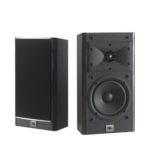
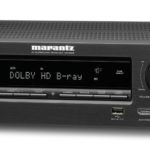
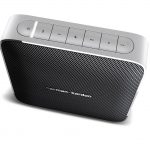
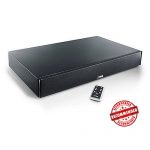
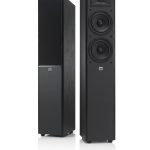
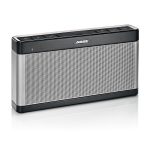
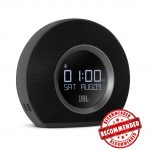
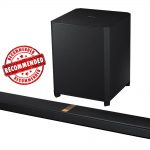
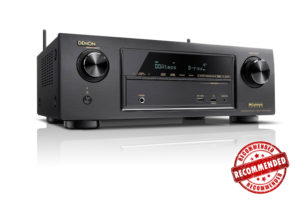


wanted to know, if I can pair AVR-X1200 with Polk Audio TL1600 speakers
Yes, that would be a pretty nice combination. You can read our review here.
How I can get firmware. Not posible through Denon Page..!!
Connect your AVR to a network using wired LAN (Ethernet cable) or wireless LAN (Wi-Fi).
To find out if your AVR has the latest firmware installed:
1. Turn on your AVR.
2. Press the “Setup” button on the remote control to access the setup menu.
3. Select “General” from the menu.
4. Then, select “Firmware”.
5. Select “Check for Update” from the Firmware menu.
If your AVR is updated, “No update required. Latest version installed” appears on the screen.
If AVR needs to be updated, follow the instructions on the menu.